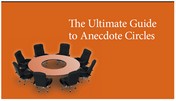Blog
Subscribe
Join over 5,000 people who receive the Anecdotally newsletter—and receive our free ebook Character Trumps Credentials.
Categories
- Anecdotes
- Business storytelling
- Collaboration
- Communication
- Corporate Storytelling
- Culture
- Decision-making
- Employee Engagement
- Events
- Fun
- Insight
- Leadership Posts
- News
- Podcast
- Selling
- Strategy
Archives
- March 2024
- December 2023
- November 2023
- October 2023
- September 2023
- August 2023
- July 2023
- June 2023
- May 2023
- April 2023
Years
Why you need to know about Anecdote Circles
 Interviews and surveys are no longer sufficient to find out what’s really happening in your business. Organisations are becoming more complex every day and as the number of connections increase understanding root causes becomes impossible. We need a way to make sense of the messiness we face. Interviews and surveys typically come laden with pre-determined thoughts of what the investigators might find and interviewees and survey respondents seem to fall into a mode of response based on what they think the inquirer is wanting to hear.
Interviews and surveys are no longer sufficient to find out what’s really happening in your business. Organisations are becoming more complex every day and as the number of connections increase understanding root causes becomes impossible. We need a way to make sense of the messiness we face. Interviews and surveys typically come laden with pre-determined thoughts of what the investigators might find and interviewees and survey respondents seem to fall into a mode of response based on what they think the inquirer is wanting to hear.
Stories reflect the messiness, reveal values and beliefs and when told in a group create an informal environment of exploration which invariably reveals insights one could never predict from the outset. Anecdote Circles is how we discover these stories. But that is not the whole story.
Anecdote circles are more than a story elicitation technique; they are an intervention in themselves. Some might say you shouldn’t start to run anecdote circles unless you are really serious about change. Once an anecdote circle process is started the change already begins.
Anecdote circles can be used as a process:
• To overcome the limitations of traditional interview and survey approaches
• For team and relationship building
• For lessons learning in project teams
• For conflict resolution
• To help collecting stories for evaluating intangible, difficult to evaluate projects
We will be releasing the ultimate guide to anecdote circles soon. Subscribers will be the first to receive it. Free!
About Andrew Rixon
Twitter •
Comments
Comments are closed.
Robert Perey & I ran a session on anecdote circles with a mixed group from NSW KM Forum & the Sydney Facilitators Network a couple of weeks ago. Tremendous fun.
The only issue was that some of the facilitators wouldn’t stop facilitating (“So what I hear you saying is…”) despite strict instructions not to.
One observation I would make is that these sessions can tap into a lot of emotion. As people begin to open up, they can very personal events. That needs to be respected and you have to be prepared for this…
Hi Matt,
I was wondering how your group went in Sydney. Great to finally hear about it.
Your absolutely right about the standard active listening practices killing stories. Asking “so what you’re saying is” is sure to suck the energy out of a story telling. Not to mention maybe even challenge what kind of ‘listening space’ there might be.
There is a listening activity that you can do where people break into 2’s. Person A is the speaker and Person B is the listener. Person B’s job is to simply provide and support a ‘listening space’ for person A. Listening is an active process. An active process which usually doesnt require any speech acts. Maybe its like the old saying. You’ve got 2 ears and 1 mouth, and thats the proportion they should be used in. 🙂
These aspects of being supportive, emotionally as well as being a supportive story listener are covered in the guide.